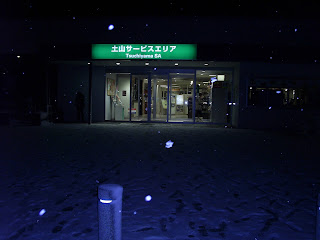 |
| CJ gets ready for a bath before we head out. |
At this point, I need it.
I was able to get one of the last tickets on a night bus from Tokyo to Kyoto for the super-sketchy night bus on Thursday. My plan is/was to organize my room for the new roommate and just in case I don't come back, pack and take the bus, arrive in Kyoto on Friday morning, stay with the priest and his family for a while, then move in with my friend Kai and then with my friend Gina. Fool proof plan since I have a friend with me every step of the way. But, of course, Thursday night is the time when I have to get all emotional and start acting like I'm never coming back. I started going around and taking pictures and videos of things, crying at every turn, saying good-bye like I'm moving away to a new city forever, and basically being a baby about the whole thing.
 |
| Hmmm, left-overs! I actually made a mountain of this stuff, but somehow managed to eat it all. |
I was only allowed to carry one large bag, one small bag, and one purse due to the bus's rules, but that was more than enough for me: after traveling with Gina and from my experience as a pk, I am well trained in the Tetris-like art of packing. After I got all my stuff packed and moved into the lobby, I went back for my food. Daddy had made sure to stress that I needed to carry nonperishable foods that needed no prep-work just in case I found that Kyoto was just as hard pressed for food as Tokyo has become. So I packed almonds, dried apples, a log of salami, crackers, and tuna packets into any extra crevices in my bags. I didn't think that I would need it all on the little trip, but I figured that I could always give it to Kai in return for staying at his house. As for my last loaf of bread, I gave that and a bottle of Meghan's Coka Cola to Matthew, who was staying in Tokyo longer than the rest of our family.
 Lastly, I interrupted Miki in the shower and told her that I'd be leaving in an hour. She followed me about for awhile as I sobbed all over Keyaki, then gave me a few presents before I left: she called her mom and let me talk with her one last time (her mom was really supportive this whole time and invited me back to their house should I ever come back to Japan), gave me a small piece of chocolate for the bus ride, and gave me a face mask for the trip down there (I think that the mask was supposed to help keep other people's germs off me and protect against the radiation somehow). She even walked me to the bus stop and used her Wadaiko-super-strength to tote my bags the whole way, but kept remarking, "You're really taking all of this with you? Unbelievable!" I don't bring many bags, but I jam-pack them full of stuff!
Lastly, I interrupted Miki in the shower and told her that I'd be leaving in an hour. She followed me about for awhile as I sobbed all over Keyaki, then gave me a few presents before I left: she called her mom and let me talk with her one last time (her mom was really supportive this whole time and invited me back to their house should I ever come back to Japan), gave me a small piece of chocolate for the bus ride, and gave me a face mask for the trip down there (I think that the mask was supposed to help keep other people's germs off me and protect against the radiation somehow). She even walked me to the bus stop and used her Wadaiko-super-strength to tote my bags the whole way, but kept remarking, "You're really taking all of this with you? Unbelievable!" I don't bring many bags, but I jam-pack them full of stuff!Instead of taking the bus, since the bus schedule was all out of wack, I got a taxi ride with another ICU exchange student named Kara. She and I were in the same Japanese class, so I knew her a little. She was actually up in Sendai when it all happened and was getting ready to run away to Okinawa that night. At the train station, we went our separate ways. Getting to the meeting place for the bus was a hassle, sine it wasn't an official stopping place, just a sidewalk that the company commender at the wee hours of the night. When I got on the bus, no one told me where to sit, but I had heard someone say that people going to Kyoto were in the front and those going to Osaka were in the back, so I sat in the front, only to have a flustered couple ask me to move to the last seat in the last row in the back. The bus was cramped, but I was used to not having much space in Tokyo. I was just happy to be sitting down out of the cold wind (since I had shown up to the meeting place an hour and a half ahead of time as to not miss the bus). I decided to take a nap, and when I woke up, the bus was stopped at this rest area and it was snowing!!! I got back on the bus took another nap, and woke up in Kyoto around 7 am.
At least I had made it to Kansai! I lugged everything to the nearest McDonald's and had a breakfast sandwich while I waited to get warm again and meet Marie, my pk friend from Canada.

